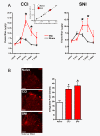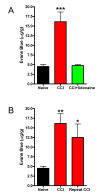Peripheral nerve injury and TRPV1-expressing primary afferent C-fibers cause opening of the blood-brain barrier
- PMID: 21044346
- PMCID: PMC2984489
- DOI: 10.1186/1744-8069-6-74
Peripheral nerve injury and TRPV1-expressing primary afferent C-fibers cause opening of the blood-brain barrier
Abstract
Background: The blood-brain barrier (BBB) plays the crucial role of limiting exposure of the central nervous system (CNS) to damaging molecules and cells. Dysfunction of the BBB is critical in a broad range of CNS disorders including neurodegeneration, inflammatory or traumatic injury to the CNS, and stroke. In peripheral tissues, the vascular-tissue permeability is normally greater than BBB permeability, but vascular leakage can be induced by efferent discharge activity in primary sensory neurons leading to plasma extravasation into the extravascular space. Whether discharge activity of sensory afferents entering the CNS may open the BBB or blood-spinal cord barrier (BSCB) remains an open question.
Results: Here we show that peripheral nerve injury (PNI) produced by either sciatic nerve constriction or transecting two of its main branches causes an increase in BSCB permeability, as assessed by using Evans Blue dye or horseradish peroxidase. The increase in BSCB permeability was not observed 6 hours after the PNI but was apparent 24 hours after the injury. The increase in BSCB permeability was transient, peaking about 24-48 hrs after PNI with BSCB integrity returning to normal levels by 7 days. The increase in BSCB permeability was prevented by administering the local anaesthetic lidocaine at the site of the nerve injury. BSCB permeability was also increased 24 hours after electrical stimulation of the sciatic nerve at intensity sufficient to activate C-fibers, but not when A-fibers only were activated. Likewise, BSCB permeability increased following application of capsaicin to the nerve. The increase in permeability caused by C-fiber stimulation or by PNI was not anatomically limited to the site of central termination of primary afferents from the sciatic nerve in the lumbar cord, but rather extended throughout the spinal cord and into the brain.
Conclusions: We have discovered that injury to a peripheral nerve and electrical stimulation of C-fibers each cause an increase in the permeability of the BSCB and the BBB. The increase in permeability is delayed in onset, peaks at about 24 hours and is dependent upon action potential propagation. As the increase is mimicked by applying capsaicin to the nerve, the most parsimonious explanation for our findings is that the increase in permeability is mediated by activation of TRPV1-expressing primary sensory neurons. Our findings may be relevant to the development of pain and neuroplastic changes in the CNS following nerve injury. In addition, our findings may provide the basis for developing methods to purposefully open the BBB when needed to increase brain penetration of therapeutic agents that might normally be excluded by an intact BBB.
Figures





References
Publication types
MeSH terms
Substances
Grants and funding
LinkOut - more resources
Full Text Sources
Other Literature Sources
Research Materials

